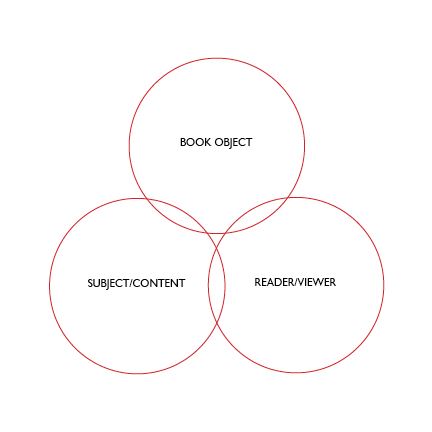As a follow-up to my previous blogpost featuring detailed descriptions of Selected Durations, Flashpoint, vvvvv, and Rain/fall, I want to spend a little more time analyzing the responses from my class “experiment.” Folded into these descriptions and definitions are a few select terms and/or ideas that seem to transcend book art epochs, audience expertise, and materials. To show some of these connections between my (mostly) novice students and book art theory and criticism, I pulled key passages from the following three texts which students read for class: Ellen Brown’s “Beyond Words: Artist’s Books”; Ulises Carrión’s “The New Art of Making Books”; and Dick Higgins’ “A Preface”, and placed them next to some particularly poignant statements made by my students. The result is three sets of bubbling conversations between the two parties.

These Venn diagrams riff off of Dick Higgins’ Intermedia Chart in the way that they visually represent intersections between categories within the [book]art world. The three categories include, books that re-present time, control time (all books?), use time as a subject (Carrión); books that make tangible an intangible subject, or stress the reading/viewing experience (Higgins); and books that are playful in the way they use imagery, structure, or text, or in the way that they encourage the viewer to engage in play (Brown). Within each of the three categories there are intersections between the existing theoretical quotations and the student statements, but the student statements often overlap as well, and all of the bubbles seem to rotate around the phrase “object lends itself to connection.” Of course, none of these statements is mutually exclusive of the other statements and some of the abstract language (by all parties involved) is due to the structure of the dynamic described in each statement: there is the book object and there is the book object’s subject/content and there is a reader/viewer that is trying to make connections between the subject/content and the book object in order to connect themselves to the overall project. I have included a simple Venn diagram to show these intersections.

I would be interested to hear if anyone sees another (4th) primary aspect within the book art trifecta. What about object and presentation space (gallery, special collections library, classroom, kitchen table at home)? And beyond the individual components (dual, in the case of subject/content and reader/viewer), how can we start to discuss the other levels of interactions, say, between subject, object, and reader/viewer in the way that they affect one another? Perhaps these abstract questions will be better addressed by using concrete book examples that exemplify the diverse interactions that artist books can create.
As a side note, while I like teaching these essays to an introductory class, I am aware of how dated they are and am actively looking for alternatives.
Work Cited
Brown, Ellen. “Beyond Words: Artist’s Books.” Modernism Magazine. Volume 11, Number 3, Fall 2008. http://publishing.yudu.com/Apt5o/MV11N3/resources/56.htm
Carrión, Ulises. “The New Art of Making Books.” Artist’ Books: A critical Anthology and Sourcebook, edited by Joan Lyons, Visual Studies Workshop Press, 1985, pp 31-44.
Higgins, Dick. “A Preface.” Artist’ Books: A critical Anthology and Sourcebook, edited by Joan Lyons, Visual Studies Workshop Press, 1985, pp 11-15.
AB Gorham is a book artist and writer from Montana. She is the Director at Black Rock Press where she teaches book arts in the Book and Publication Arts Program. Her artist books have been exhibited and collected nationally.

